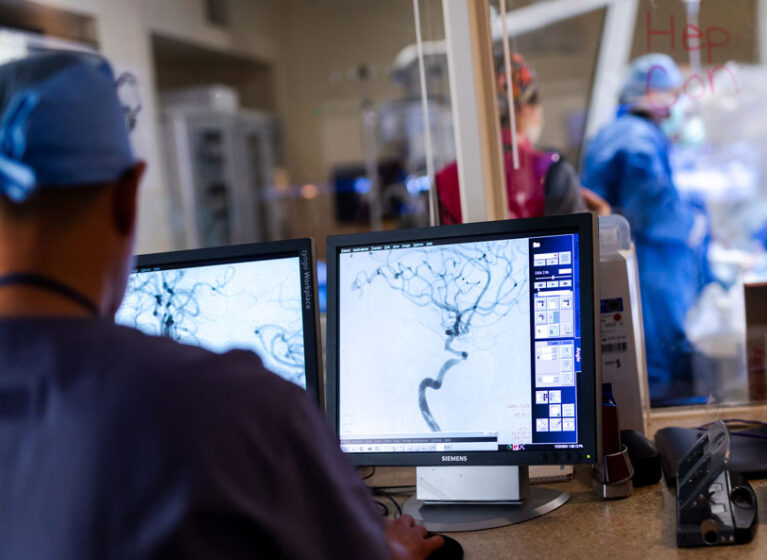
New analysis from the Stroke Hyperglycemia Insulin Network Effort (SHINE) trial has found a link between high blood sugar after thrombolytic treatment and life-threatening brain bleeds, especially in older patients with severe strokes. This study, led by Andrew Southerland, MD, professor in the Division of Vascular Neurology, also found efforts to lower blood sugar with aggressive insulin administration was not associated with reduced risk of bleeding.
Originally a large, multi-center randomized clinical trial sponsored by the National Institutes of Health, the SHINE trial was a neuroemergency trial run across 70 institutions and led by Karen Johnston, MD, Harrison Distinguished Professor of Neurology and Associate Vice President for Clinical and Translational Research. The trial initially focused on the best management for stroke patients with high blood sugar and balanced enrollment by treatment with clot-busting therapy.
Trial enrollment wrapped in 2018, but data from the cohort has proven to be a treasure trove for researchers looking for clinically translatable outcomes in stroke patients regarding blood sugar, treatment strategies, and more.
Same Data, New Research Avenues
Southerland’s analysis of the SHINE trial data evaluated if management of blood sugar made a difference in safety for patients receiving thrombolysis (formerly, the clot-busting drug, tPA). That evaluation is crucial in the clinical setting since the most concerning risk in using these clot-busting interventions is life-threatening intracranial bleeding.
Researchers already recognize this connection for patients with elevated blood pressure, but the impetus for Southerland’s sub-study was to see if the same was true for high blood sugar and if methods to lower blood sugar had any impact on the risk for brain bleeds.
During the trial, more than 60% of patients received thrombolysis as a pharmaceutical intervention. Of these patients, one group received an intensive insulin protocol. The other group received smaller doses of insulin on a sliding scale depending on their original blood sugar count.
While the researchers didn’t see a difference in reducing the risk of hemorrhage between the two groups, they did find a reliable association between hyperglycemia and the risk of hemorrhage. This was especially evident in older patients or those more severely impacted by stroke. In particular, the sooner that patients’ blood sugar got below 180, the researchers saw a reduced risk of symptomatic intracerebral hemorrhage.
“Reducing the risk of post-stroke hemorrhage can improve outcomes, but blood sugar is one of the areas that we don’t have a lot of good guidance for management,” says Southerland. “Based on what we have seen from this trial, there is not enough evidence to support aggressive treatment of hyperglycemia with an intensive insulin drip protocol.”
Understanding How Hyperglycemia Impacts Outcomes
Moving forward, the SHINE trial gives researchers a baseline for future studies on the association between hyperglycemia and outcomes in patients with severe ischemic strokes receiving thrombolysis. One area of opportunity is improving basic science understanding of why high blood sugar tends to be associated with high risks of bleeding and worse outcomes, especially with severe strokes.
Another area of future research is understanding why injured brain tissue is vulnerable to high blood sugar and how this may relate to procedural endovascular therapy (i.e. mechanical clot removal) to achieve better outcomes. These benefits could lead to neuro-protection interventions that providers could apply as early as in the ambulance on the way to the hospital to help preserve the brain.
“Getting the clot out and restoring blood flow is the final step of ending the stroke event, but we need to understand how to sustain the brain before the tissue dies,” says Southerland. “With modern imaging and new techniques like catheter-based clot retrieval, clinicians have a lot more information about what is happening with the stroke that we can learn from during future research.”
Applying SHINE Outcomes to Clinical Care
Learnings from the SHINE trial have translated directly into acute stroke treatment — especially in the emergency department. UVA Health brings a robust internal research infrastructure, including for high-quality clinical and translational research, that enables new studies to get translated into clinical practice in these scenarios.
On the clinical side, UVA Health is well-positioned to bring these fresh learnings to its patients, since the system is accredited by the Joint Commission as a Comprehensive Stroke Center. UVA Health is also a transfer destination in the region for stroke care. With thousands of acute patients coming on-site every year, clinicians and researchers collaborate to provide leading-edge therapy from the emergency department to the neuro-intensive care unit and beyond.
Many of the patients who could benefit from this research are those suffering from large vessel occlusion stroke. These only account for 10-20% of strokes that come into the emergency department but are associated with the worst outcomes.
“Whether it’s a big academic center or small community hospital, these learnings are empowering physicians to make decisions about the use of clot-busting medications,” says Southerland. “Time is brain, and every minute we don’t treat a stroke patient can alter their outcomes. Emergency providers have concerns about risk of hemorrhage in stroke treatment and this research informs future studies that will hopefully help make these life-saving stroke treatments safer for all patients.”